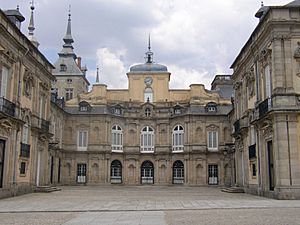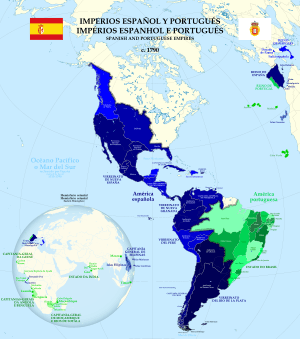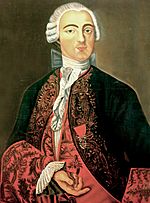First Treaty of San Ildefonso facts for kids
| Treaty of Peace and territorial limits between Spain and Portugal. | |
|---|---|

Palacio La Granja, where the Treaty was signed
|
|
| Context | Spain and Portugal settle territorial disputes in the Río de la Plata region |
| Signed | 1 October 1777 |
| Location | Real Sitio de San Ildefonso |
| Negotiators |
|
| Parties | |
The First Treaty of San Ildefonso was an important agreement signed on 1 October 1777 between Spain and Portugal. It helped these two kingdoms finally settle their long-standing disagreements over land in South America, especially in the Río de la Plata region.
Why the Treaty Was Needed
For almost 300 years, Spain and Portugal argued about their borders in the Río de la Plata area. This was because they had different ideas about an old agreement called the Treaty of Tordesillas. Even though Spain's silver mines in Potosí were far away, Portugal kept trying to take over the silver-rich land for its Brazilian colonies.
The two countries tried to fix their problems with the 1750 Treaty of Madrid. But in 1761, the new Spanish king, Charles III, cancelled it. In 1762, Spain joined France in the Seven Years' War, which led to a short conflict called the Fantastic War of 1762-1763.
With help from Britain, Portugal managed to stop an invasion from France and Spain in Europe. In South America, Spain captured the Portuguese port of Colonia del Sacramento (which is now in Uruguay) and a large part of what is today the Brazilian state of Rio Grande do Sul. However, the Treaty of Paris in 1763 made Spain give Colonia del Sacramento back. By 1777, Portugal had taken back Rio Grande do Sul.
Most of Spanish South America was controlled by the Viceroyalty of Peru. This meant all trade had to go through Lima, a city on the Pacific coast. This rule made imported goods very expensive. It also stopped the Atlantic coast from growing economically. People became unhappy with Spanish rule because of this.
Portuguese traders used the Río de la Plata area to bring in illegal goods and avoid these trade rules. Soon, Buenos Aires became a major center for smuggled items. To get back control, Spain created a new area called the Viceroyalty of the Rio de la Plata in 1776, with Buenos Aires as its capital. Even though Lima didn't like it, some free trade was allowed between Buenos Aires, Montevideo, and Spain.
Between 1775 and 1776, the fighting between Spain and Portugal in the region got worse, even though the Spanish–Portuguese War officially started in 1776. In February 1777, Pedro Antonio de Cevallos, the new leader of the Río de la Plata, took charge of a Spanish force of 116 ships and 19,000 soldiers. He captured Santa Catarina island in February. Then he moved to Colonia del Sacramento, which surrendered in July.
In August, Cevallos found out that Joseph I of Portugal had died in February. His daughter, Maria I, then asked for peace, and the fighting stopped.
What the Treaty Decided
Under the Treaty, Portugal gave up Colonia del Sacramento, the nearby island of San Gabriel, and a region called Misiones Orientales. In return, Spain recognized Portugal's control over Southern Brazil and gave Santa Catarina island back.
The Treaty also set up a group to draw the exact borders between the Portuguese and Spanish colonies. These borders were later confirmed by the 1778 Treaty of El Pardo. Portugal also agreed to stop illegal trading and not let ships from countries that were enemies of Spain use its ports. This rule was mainly aimed at Britain, with whom Spain was at war from 1779 to 1783.
After the Treaty
King Charles of Spain hoped that settling the border would help the new Viceroyalty grow economically and make its people happier. It was partly successful, but development was slowed down by the 1779-1783 war with Britain. This war limited trade with Spain and led to high taxes to pay for it.
Smuggling goods without paying taxes remained a very profitable activity. Also, heavy taxes and "voluntary" donations caused unrest. One example was the 1781 Revolt of the Comuneros in the Viceroyalty of New Granada.
Portugal got the Misiones Orientales back in the Treaty of Badajoz (1801). Spain's involvement in the Napoleonic Wars and losing many ships at the Battle of Trafalgar in 1805 cut off communication between the Spanish government and its colonies in the Americas. British attacks on Buenos Aires and Montevideo in 1806 and 1807 were stopped by local forces. This gave the colonists the confidence to demand self-rule. The Viceroyalty of Río de la Plata broke apart during the 1810-1818 Argentine War of Independence.
The Misiones Orientales region was where Jesuit missionaries worked with the Guarani people. This story was later told in the 1986 film The Mission, starring Robert De Niro.
See also
 In Spanish: Tratado de San Ildefonso (1777) para niños
In Spanish: Tratado de San Ildefonso (1777) para niños





